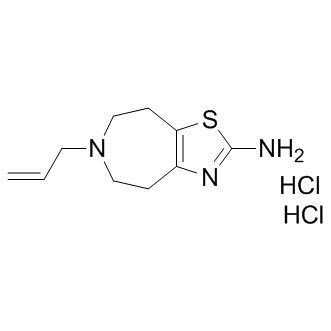| Reference | <p style=/line-height:25px/>
1 . Nishikawa T, Yamada S, Tsuda A, Tanaka M, Koga I, Uchida Y.Chronic treatment with talipexole dihydrochloride on abnormal involuntary movement in humans.Clin Neuropharmacol. 1990 Jun;13(3):259-63.
Abstract
Two cases of severe dystonia and dyskinesia were treated with talipexole, a dopamine autoreceptor agonist, and the metabolites of dopamine, norepinephrine, and serotonin in cerebrospinal fluid (CSF) were determined. Despite significant reductions in these metabolites in CSF, behavioral amelioration of these cases could not be observed. The present findings argue for further studies to explore the clinical usefulness of dopaminergic agonists such as talipexole.
2 . Momiyama T, Sasa M, Takaori S.Inhibition by talipexole, a thiazolo-azepine derivative, of dopaminergic neurons in the ventral tegmental area.Life Sci. 1991;49(7):535-43.
Abstract
A microiontophoretic study using rats anesthetized with chloral hydrate and immobilized with gallamine triethiodide was carried out to compare the effect of talipexole (B-HT 920 CL2:2-amino-6-allyl-5,6,7,8-tetrahydro-4H-thiazolo [4,5-d]-azepine-dihydrochloride), a dopamine autoreceptor agonist, on dopaminergic neurons in the ventral tegmental area (VTA) to non-dopaminergic neurons in the VTA. VTA neurons were classified into two types according to the responses to antidromic stimulation of the nucleus accumbens (Acc): type I neurons with a long spike latency (8.69 +/- 0.24 msec) upon Acc stimulation and low spontaneous firing rate (6.80 +/- 1.34/sec), and type II neurons with a short latency (2.76 +/- 0.20 msec) and high spontaneous firing rate (26.77 +/- 7.05/sec), probably corresponding to dopaminergic and non-dopaminergic neurons, respectively. In type I neurons, microiontophoretic application of talipexole and dopamine inhibited antidromic spike generation elicited by Acc stimulation, and talipexole-induced inhibition was antagonized by domperidone (dopamine D-2 antagonist). In type II neurons, however, the antidromic spikes were not affected by either talipexole or dopamine. Furthermore, spontaneous firing was also inhibited by iontophoretically applied talipexole and dopamine in most type I neurons, but rarely affected by either drug. Inhibitory effects of talipexole were antagonized by domperidone. These results suggest that talipexole acts on dopamine D-2 receptors, thereby inhibiting the dopaminergic neurons in the VTA.
3 . Kohno Y, Fukuzaki K, Kitahara K, Koja T.Anti-tremor activity of talipexole produced by selective dopamine D2 receptor stimulation in cynomolgus monkeys with unilateral lesions in the ventromedial tegmentum.Eur J Pharmacol. 1997 Jan 29;319(2-3):197-205.
Abstract
The anti-tremor activity of talipexole (6-allyl-2-amino-5,6,7,8-tetrahydro-4H-thiazolo[4,5-d]azepine dihydrochloride, B-HT 920 CL2, Domin), a non-ergot dopamine D2 receptor agonist which possesses alpha 2-adrenoceptor agonistic and 5-HT3 receptor antagonistic properties, was examined in monkeys with a unilateral lesion in the ventromedial tegmentum. Talipexole dose dependently suppressed the tremor and had ED50 values of 34 micrograms/kg s.c. and 84 micrograms/kg p.o. The anti-tremor effect of talipexole occurred at much lower doses than that of an ergot dopamine receptor agonist, bromocriptine (2-bromo-alpha-ergocryptine mesilate, ED50; 2.5 mg/kg s.c.), and talipexole acted synergistically in combination with L-DOPA (3,4-dihydroxyphenylalanine). In ventromedial tegmentum-lesioned monkeys, anti-tremor doses of talipexole did not cause emetic behavior, but had sedative effects. Conversely, monkeys given bromocriptine exhibited oral movement, salivation and vomiting when anti-tremor effects were observed, but not marked sedative behavior at any of the doses investigated. During repeated administration of talipexole (a daily dose of 50 micrograms/kg s.c. for 21 days), the extent and duration of the anti-tremor effect did not change, but those of the sedative effect decreased gradually. The anti-tremor effect of talipexole was significantly suppressed by sulpiride, but not by SCH 23390 (7-chloro-2,3,4,5-tetrahydro-3-methyl-5-phenyl-1H-3-benzazepine-7-ol) or yohimbine, while the sedative effect was inhibited by sulpiride and yohimbine. The main metabolites of talipexole had no anti-tremor or sedative effects. These results indicate that talipexole exerts its anti-tremor activity via selective dopamine D2 receptor stimulation.
4 . Eur J Pharmacol. 1997 May 1;325(2-3):137-44.
Abstract
The effects of two predominant dopamine D2-like receptor agonists, talipexole (6-allyl-2-amino-5,6,7,8-tetrahydro-4H-thiazolo [4,5-d]-azepine dihydrochloride, B-HT 920 CL2) and pramipexole (S(-)2-amino-4,5,6,7-tetrahydro-6-propyl-aminobenzothiazole dihydrochloride, SND 919 CL2Y), were studied alone and in combination with the selective dopamine D1-like receptor agonist chloro-APB ((+/-)6-chloro-7-8-dihydroxy-3-allyl-1-phenyl-2,3,4,5-tetrahydro-1H-benz azepine hydrobromide, SKF 82958) in five chronic 1-methyl-4-phenyl-1,2,3,6-tetrahydropyridine (MPTP) lesioned hemiparkinsonian Macaca nemestrina monkeys. Talipexole induced contraversive rotation in a dose-dependent manner up to 32 microg/kg, i.m. Talipexole was more potent than pramipexole (10 vs. 32 microg/kg, i.m.), but pramipexole was more efficacious in producing contraversive rotational behavior and significant hand movements in the afflicted limb. Larger doses of chloro-APB also produced contraversive rotation. Combinations of each dopamine D2-like receptor agonist in a median effective dose with chloro-APB (23.4 and 74.8 microg/kg, i.m.) had synergistic effects, producing either addition or potentiation, depending upon the dose used. The effects noted with these combinations were less than the effect of a large dose (100 microg/kg) of pramipexole. Talipexole, in the largest dose studied (100 microg/kg, i.m.), produced sedation which was not seen with the same dose of pramipexole. No significant extrapyramidal side effects were noted with either agent.
5 . Ricci and Taira Adrenoceptor involvement in the cardiovascular responses to B-HT 920 in sinoaortic denervated rats. Gen.Pharmacol. (1999)32 29.
Abstract
A study was made relating the involvement of alpha-adrenoceptors in the cardiovascular responses to intracerebroventricular (i.c.v.) injection of B-HT 920, a clonidine-type drug, in conscious sham-operated and sinoaortic-denervated rats. 2. Wistar rats were used, 7 days after the sham operation or sinoaortic denervation. For i.c.v. injection of drugs, a guide cannula had been previously implanted in the left lateral ventricle. 3. In sham-operated rats, cardiovascular responses to B-HT 920 (10-60 microg) were increased blood pressure and bradycardia; but, in sinoaortic-denervated rats, after the pressor response, a decrease in blood pressure also was seen. …
</p>
|

